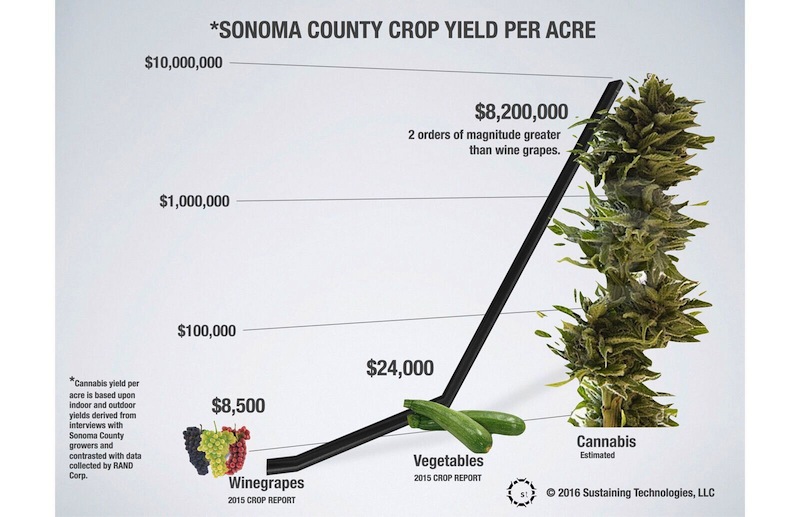Legal Cannabis Farming Could Lead to Unique Farmpreneur Mashups.
As Sonoma County regulators and policy makers work to figure out where and how to permit cannabis cultivation, a prime opportunity has arisen to examine the potential for alliances between existing fruit and vegetable farmers and cannabis growers.
Vegetable farming is a notoriously difficult business. Cannabis farming offers an opportunity to return the farmer to a profitable enterprise—very quickly. Cannabis doesn’t require the chore of processing into value-added forms to be highly valuable. Dry it, trim it, and it’s ready to go to market.
The challenges, of course, are that its scarcity has been driven primarily by its illegality, not by its relative difficulty to grow. In addition to scarcity, the risk to produce cannabis has driven up prices. What happens when it’s legal to grow, sell, and consume, and anyone with a license can get in on the game?
That has to be the major conundrum facing growers as well as policymakers and regulators. After all, it seems that a common goal of both the regulators and the regulated is to keep the first few years’ production to a minimum—no greater than current amounts—to stabilize the ship.
Price instability doesn’t serve the interest of the state or the industry, but it does serve special interests of would-be disrupters. The role of policy and regulators ought to be to constrain that instability.
According to the new proposed Sonoma County permit regulations, if you want to grow 500 square feet of cannabis outdoors, you need a minimum of two acres. That means cannabis can only take up one percent of the whole parcel. It seems a bit extreme, but maybe that will change before all is said and done with the county ordinance this fall. For larger grows, say one acre, the required parcel is 10 acres, far more than a cannabis farmer needs, but more aligned with the size of land base other farmers could use.
Think about it this way: Let’s say you’re a veggie farmer making $50,000 per acre on a three-acre farm. What if you teamed up with a legally permitted cannabis grower who planted a one-fourth acre plot within your parcel under a lease agreement.
The two of you share responsibilities from cultivation through harvest. Then, the vegetable farmer gets to share in a percent of the market yield, a substantial amount when compared to vegetables (see chart). The cannabis farmer takes the responsibility for getting the product into the cannabis supply chain.
As a farmer, the temptation is to just do it by yourself, which of course some farmers are doing now. But let’s say you’re not that farmer; you want to stick to your wheelhouse but want to share in an upside without the pain of all else that comes with marketing cannabis through the supply chain.
This could be a way for some Sonoma County farmers to expand fruit and vegetable production onto more acreage (larger parcels) if land acquisition cost has been the barrier.
Here’s what Evan Wiig, executive director of the Farmer’s Guild, had to say about the idea: “Farmers in the North Bay, in particular new and young farmers, face huge obstacles when competing for farmland with more lucrative development and wine. But with rules currently being written for the emerging cannabis industry, what if instead of adding to those pressures the inevitable cultivation of that more lucrative crop empowered more necessary crops like fruits and vegetables? Why not be proactive and find synergy?”
Tawnie Logan, executive director of Sonoma County Growers Alliance says, “Cannabis is an agricultural product; it belongs on the farm with the fruit trees, veggies, sunshine, and people.”
This could be a way for some Sonoma County farmers to expand fruit and vegetable production onto more acreage especially if the cost of acquiring land for farming has been a barrier to launching or expanding a business.
Is there an opportunity here for both vegetable farmers and cannabis growers? Email us at editor@madelocal.coop and let us know what you think.
